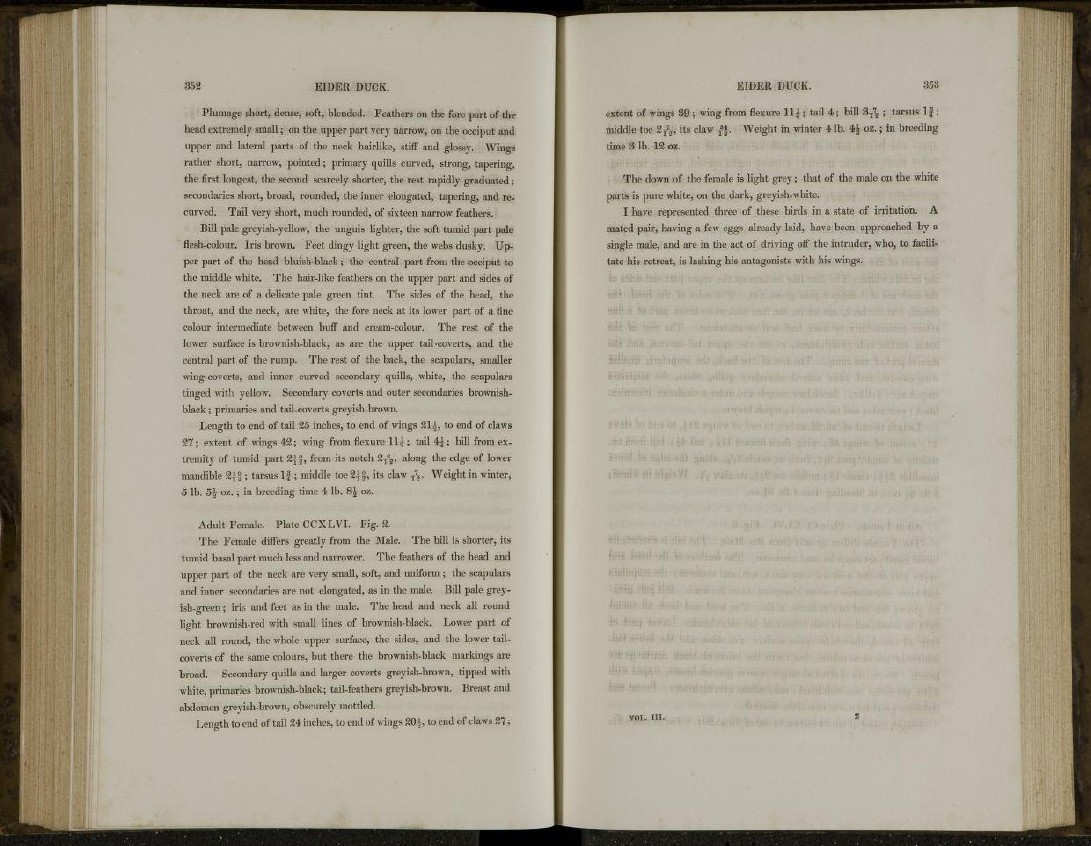
Plumage short, dense, soft, blended. Feathers on the fore part of the
head extremely small; on the upper part very narrow, on the occiput and
upper and lateral parts of the neck hairlike, stiff and glossy. Wings
rather short, narrow, pointed; primary quills curved, strong, tapering,
the first longest, the second scarcely shorter, the rest rapidly graduated;
secondaries short, broad, rounded, the inner elongated, tapering, and recurved.
Tail very short, much rounded, of sixteen narrow feathers.
Bill pale greyish-yellow, the unguis lighter, the soft tumid part pale
flesh-colour. Iris brown. Feet dingy light green, the webs dusky. Upper
part of the head bluish-black; the central part from the occiput to
the middle white. The hair-like feathers on the upper part and sides of
the neck are of a delicate pale green tint. The sides of the head, the
throat, and the neck, are white, the fore neck at its lower part of a fine
colour intermediate between buff and cream-colour. The rest of the
lower surface is brownish-black, as are the upper tail-coverts, and the
central part of the rump. The rest of the back, the scapulars, smaller
wing-coverts, and inner curved secondary quills, white, the scapulars
tinged with yellow. Secondary coverts and outer secondaries brownishblack
; primaries and tail-coverts greyish-brown.
Length to end of tail 25 inches, to end of wings 211, to end of claws
27; extent of wings 42; wing from flexure 11£; tail 4£; bill from extremity
of tumid part 2{§, from its notch 2 ^ , along the edge of lower
mandible %{% ; tarsus If ; middle toe 2]8, its claw T
7
2 . Weight in winter,
5 lb. 5^j oz.; in breeding time 4 lb. S\ oz.
Adult Female. Plate CCXLVI. Fig. 2.
The Female differs greatly from the Male. The bill is shorter, its
tumid basal part much less and narrower. The feathers of the head and
upper part of the neck are very small, soft, and uniform ; the scapulars
and inner secondaries are not elongated, as in the male. Bill pale greyish
green ; iris and feet as in the male. The head and neck all round
light brownish-red with small lines of brownish-black. Lower part of
neck all round, the whole upper surface, the sides, and the lower tailcoverts
of the same colours, but there the brownish-black markings are
broad. Secondary quills and larger coverts greyish-brown, tipped with
white, primaries brownish-black; tail-feathers greyish-brown. Breast and
abdomen greyish-brown, obscurely mottled.
Length to end of tail 24 inches, to end of wings 20£, to end of claws 27;
extent of wings 39 ; wing from flexure 11£; tail 4; bill ST\ ; tarsus If;
middle toe 2T
7^, its claw Weight in winter 4 lb. 4£ oz.; in breeding
time 3 lb. 12 oz.
The down of the female is light grey; that of the male on the white
parts is pure white, on the dark, greyish-white.
I have represented three of these birds in a state of irritation. A
mated pair, having a few eggs already laid, have been approached by a
single male, and are in the act of driving off the intruder, who, to facilitate
his retreat, is lashing his antagonists with his wings.
VOL. III.